Sd.Kfz.251 / 23 combat reconnaissance vehicle (Germany)
The first mentions of the Sd.Kfz.251 / 23 project refer to the last days of December 1944. This may partially reveal some of the prerequisites for the emergence of the project. Apparently, the most serious problems with the quantity and quality of the necessary equipment made the German command once again resort to the construction of armored vehicles based on the existing structures. As part of the next project, the designers were required to adapt the existing medium armored personnel carrier to install the finished turret with machine guns and cannon armament.
The new Sd.Kfz.251 / 23 project was supposed to be based on the same ideas as Sd.Kfz.250 / 9, developed at the end of 1941. The design of the existing semi-tracked armored personnel carrier was required to make some changes, after which he could become the carrier of the existing combat compartment. At this time, the combat module with the 20-mm cannon and machine gun, as well as other equipment, was proposed to be borrowed from the Sd.Kfz.234 / 1 armored vehicle. It is noteworthy that the proposed to use the tower type Hängelafette 38 was a slightly modified unit of the old Sd.Kfz.222 armored car. Thus, the two variants of the half-track reconnaissance vehicle should have had similarities not only in terms of the chassis design.
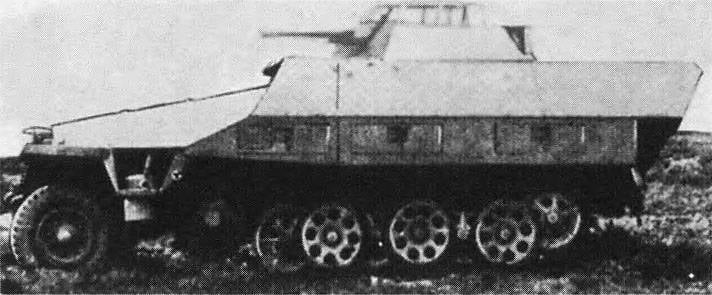
General view of the BRM Sd.Kfz.251 / 23. Photo by Chamberlain P., Doyle H. "Complete German Reference tanks and self-propelled guns of World War II "
A promising project received the official designation mittlerer Schützenpanzerwagen 2 cm or 2 cm Hängelafette 38 auf mittlerer Schützenpanzerwagen. The name Sd.Kfz.251 / 23 was also used, reflecting the serial number of the engineering project based on the existing chassis. The factory designation of the project is Gerät 923. It is easy to notice that in the nomenclature of vehicles based on the Sd.Kfz.251 BTR there were certain regularities and peculiar traditions.
The Sd.Kfz.251 / 23 project started at the very end of 1944, which accordingly affected the composition of the main components of the technology. The Sd.Kfz.251 armored vehicle Ausf.D was selected as the basis for the promising BRM. There was also a theoretical possibility of using the chassis of previous versions, but the industry could hardly use it in practice. Medium semi-tracked armored personnel carriers of various modifications differed from each other, primarily, the hull design. The modernization project under the letter “D” meant a noticeable simplification of the design, aimed at reducing the cost of production.
The armored personnel carrier selected for the new project had a body with anti-bullet and anti-fragmentation protection consisting of sheets from 8 to 15 mm thick. The most powerful protection was used in the frontal part of the hull, while the sides and the stern were distinguished by a smaller thickness of parts. The hull was divided into two main parts. The front engine compartment had a sloping roof with beveled side parts, and also received a hexagonal sloping frontal sheet. Protection of the crew and the assault force was placed on the sides of a complex shape with the upper part littered with the inside and additional drawers for the property on the fenders. There was feed, consisting of one leaf tilted back.
In connection with the requirements for installing a new combat unit, the authors of the mittlerer Schützenpanzerwagen 2 cm project had to equip the existing armored body with a roof. The entire upper part of the habitable compartment was overlapped with an armor plate. In the central part of the roof was provided a shoulder strap for mounting the tower with weapons. Such a revision made it possible to install the required weapons, and also to a certain extent, improve the level of protection of the armored vehicle.
The Maybach HL 42TUKRM hp 99 gasoline engine should be located under the armored hood. The engine mated with a mechanical transmission based on a gearbox with four forward speeds and two reverse gears. The gearbox and other transmission devices were responsible for transmitting engine torque to the drive wheels of the tracks. Front-wheel drive was missing. As part of the transmission, mechanisms were provided for redistributing power to the drive wheels of the tracks, which were used when turning the machine through a large angle.
A characteristic feature of the Bd Sd.Kfz.251 of all modifications was the semi-tracked undercarriage, which had certain positive features. In front of the car, a bridge with a spring suspension and a pair of steered wheels was installed. Tracked propulsion had six road wheels on board. The rollers were staggered and had an individual torsion suspension. The drive wheels were placed in the front of the track, the guides in the rear. Due to the large diameter of the road wheels, the running gear did not need support rollers.
The Hängelafette 38 turret, borrowed from the Sd.Kfz.234 / 1 heavy armored car, should be located on the new hull roof. This tower was an armored unit with frontal sheets 30 mm thick and 10-mm sides. The tower had a hexagonal shape with a wedge-shaped frontal and aft parts. To improve the level of protection, the sheets of the tower were mounted with a slope inward. In the frontal parts of the tower were provided slots for the installation of weapons. On the feeding sheets it was proposed to fix the boxes for the property.
An interesting feature of the proposed use of the tower was the lack of a roof. Instead of a solid armor plate on top of the combat compartment was covered with two frames with nets. This design of the tower to some extent simplified monitoring of the environment, and also protected the fighting compartment from the grenades. In addition, the hinged frame design on the hinge mountings made it possible to open the "roof" for firing at air targets.
The 2cm KwK 38 automatic cannon was located in the central part of the used turret. The gun had a rifled barrel with a length of 55 gauges, and its automatic equipment made it possible to fire up to 450 shots per minute. For use offered a wide range of ammunition for different purposes. Shells could reach initial speeds up to 1050 m / s and, at a distance of 500 m, punch up to 20 mm of homogeneous armor. The gun was mounted in a rocking installation, which allowed to direct it vertically from -4 ° to + 85 °, which ensured firing on both ground and air targets. Due to the rotation of the tower, circular horizontal guidance was performed.
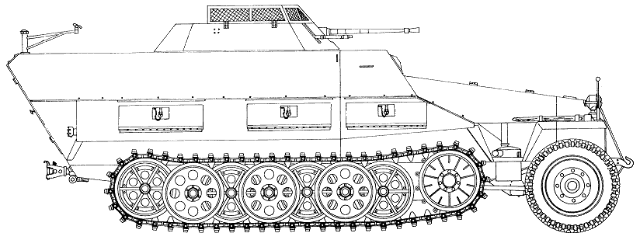
Scheme of the reconnaissance machine. Figure Heer46.blogspot.ru
To the left of the gun was a machine gun rifle caliber type MG 34 or MG 42. His guidance was carried out using common systems with a gun. At the same time for firing a machine gun should use a separate sight. In the sub-combat space of the combat compartment, it was possible to place boxes for ammunition, which contained 100 shells for a cannon and 2010 cartridges for a machine gun.
The crew of the military reconnaissance vehicle Sd.Kfz.251 / 23 consisted of four people. In front of the habitable compartment was placed the driver. Also inside the case was the radio operator who ran the FuG 12 radio station. Two more crew members were placed in the fighting compartment and controlled weapons. Their places were on both sides of the gun in the tower. The gunner was located at the starboard, the commander - at the left.
After installing the new tower, the weight and dimensions of the machine changed, but only slightly. The length of the combat reconnaissance vehicle was 5,9 m, width - 2,7 m. The height, due to the installation of the tower, increased to about 2 m. The combat mass did not exceed 10 t. The mobility parameters as a whole were to remain at the same level. Maximum speed - up to 50 km / h, power reserve - up to 300 km.
The first samples of promising BRM were built no earlier than December 1944 of the year. Apparently, they underwent short-range testing grounds, after which the German military leadership had to decide on the future fate of the new technology. Information about subsequent events vary. Some sources mention that at the beginning of 45, the German leadership attempted to incorporate a promising semi-tracked reconnaissance vehicle into the construction plan for military vehicles. Whether production was begun is not known for certain. Probably, the decision on the serial release of Sd.Kfz.251 / 23 - if it was made - appeared too late to be able to execute.
At the end of 1944 and the beginning of 1945, the situation on all European fronts was constantly deteriorating from the point of view of Germany. By the beginning of 45, the German troops, retreating, left the enemy significant areas in which industrial enterprises remained. In addition, the advancing Allies caused them serious damage, including in equipment and armaments. In such a situation, the deployment of a serial assembly of new technology turned out to be an extremely difficult task. Due to the characteristic difficulties of this period, a number of German promising projects of armaments and military equipment were never brought to mass production.
You can build various assumptions about the consequences of bringing the mittlerer Schützenpanzerwagen 2 cm project to serial assembly of equipment. Probably, new reconnaissance vehicles would be built only on the basis of Sd.Kfz.251 Ausf.D armored personnel carriers due to the lack of a significant amount of equipment of previous modifications. In addition, as the basis for the BRM could not be used new armored personnel carriers, and the machines returned to the rear for repair. A similar approach was repeatedly used by the German industry in the creation and production of new models of armored vehicles of various classes and types, based on existing platforms.
There is reason to believe that the lack of significant and unacceptable growth of the armored vehicle associated with the processing of its design would allow the BRM Sd.Kfz.251 / 23 to maintain acceptable mobility indicators at the level of the base armored personnel carrier. In this case, the possibility of parallel operation of machines of different types appeared without the risk of any problems associated with the difference in mobility. For example, BRM could be used to strengthen the units of "linear" armored personnel carriers. Similar parallel protection could also contribute to such parallel operation.
Sd.Kfz.251 / 23 reconnaissance vehicles were to be equipped with a Hängelafette 38 type combat compartment, borrowed from previous armored vehicles. This system, in general, performed well in previous years and could be used to solve various tasks until the end of the war. Nevertheless, the use of 20-mm guns did not leave the armored vehicle carrier a chance when meeting with enemy tanks, and also limited the combat potential in a collision with field artillery. Against infantry and unprotected vehicles, however, the 2 cm KwK 38 cannon and the MG 34 / 42 machine gun could be used with sufficiently high efficiency. The design of the tower also allowed the use of BRM as an anti-aircraft self-propelled gun, but its characteristics weapons could not provide an acceptable probability of hitting air targets.
Many German armored vehicles developed during World War II appeared too late. Because of this, they did not have time for some major battles, and in addition, they were released in insufficient quantities due to the limited capabilities of the industry. As a result, the promising armored vehicles for various purposes with different weapons and special purposes had no opportunity to significantly influence the course of the war. At the final stage of the Second World War, this trend changed and only aggravated the position of Hitler's Germany. Some samples of military equipment, on which the last hope was placed, could not advance at all beyond designing or testing prototypes.
The project of the mittlerer Schützenpanzerwagen 2 cm combat reconnaissance vehicle soon after its appearance added to the list of curious developments that simply did not have time for the war. No more than a few prototypes were built, and mass production never began. After the war, prototypes, no longer of any interest, were disposed of. Now they can be seen only in a few photographs, allowing to make an impression about the developed car. Due to the imminent completion of the war and the surrender of Germany, the Sd.Kfz.251 / 23 project was the last German attempt to develop a combat reconnaissance vehicle based on the existing semi-tracked armored personnel carrier.
Based on:
http://tanks-encyclopedia.com/
http://achtungpanzer.com/
http://wwiivehicles.com/
http://pro-tank.ru/
http://armor.kiev.ua/
http://forum.axishistory.com/
Chamberlain P., Doyle H. Complete reference book of German tanks and self-propelled guns of the Second World War. - M .: AST: Astrel, 2008.
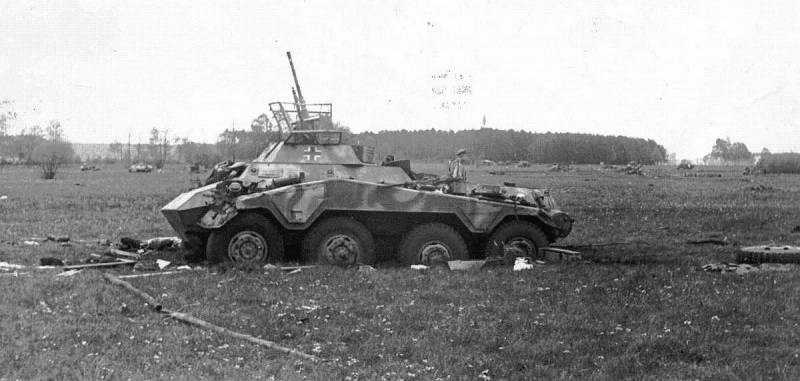
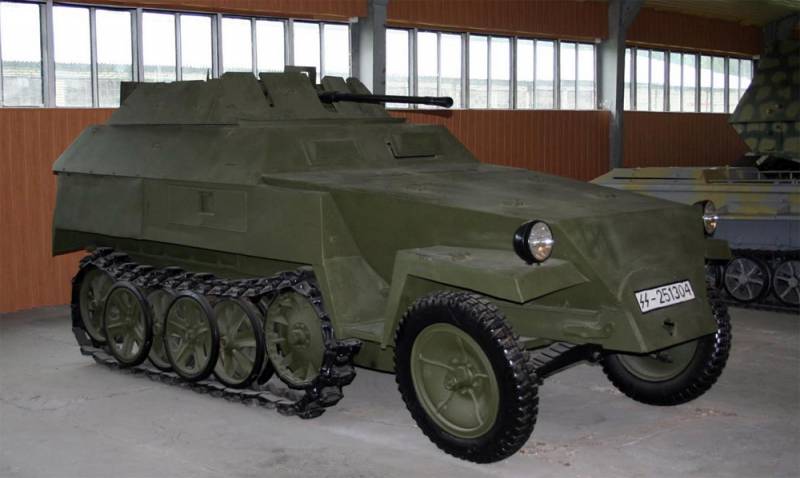
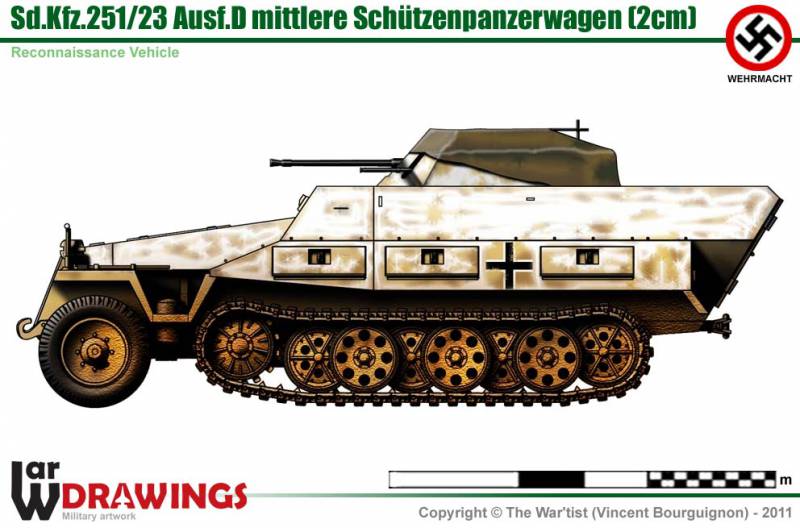
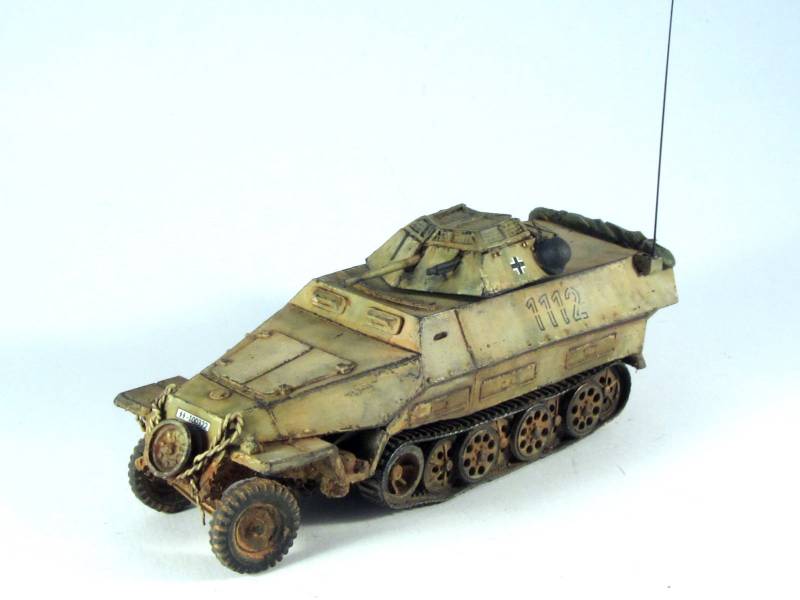
Information